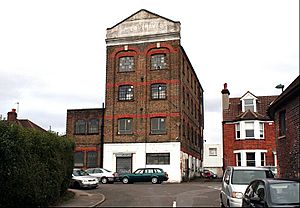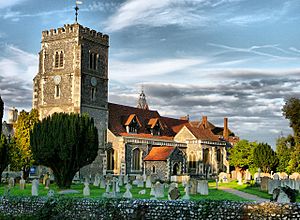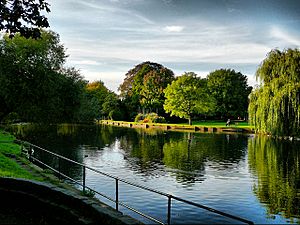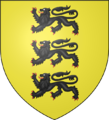Beddington facts for kids
Quick facts for kids Beddington |
|
|---|---|
 Beddington Park in the London Borough of Sutton |
|
| Population | 21,004 |
| OS grid reference | TQ305655 |
| London borough | |
| Ceremonial county | Greater London |
| Region | |
| Country | England |
| Sovereign state | United Kingdom |
| Post town | Wallington |
| Postcode district | SM6 |
| Post town | Croydon |
| Postcode district | CR0 |
| Dialling code | 020 |
| Police | Metropolitan |
| Fire | London |
| Ambulance | London |
| EU Parliament | London |
| UK Parliament |
|
| London Assembly |
|
Beddington is a suburban area in London. It sits right on the edge of the London Borough of Sutton and the London Borough of Croydon. Beddington grew from an old village. Until the early 1900s, it included land that is now known as Wallington. Wallington was once called Hakebrug in the 1200s, named after a bridge over the River Wandle.
Today, Beddington has a beautiful park called Beddington Park, also known as Carew Manor. There's also a nature reserve and a water treatment plant. In 2011, about 21,044 people lived in Beddington.
Beddington is part of the Carshalton and Wallington area. This area is represented in the UK Parliament by Conservative politician Elliot Colburn. Beddington elects six councillors to Sutton Council. Three of these councillors are from the Liberal Democrats, and three are Independents.
Contents
History of Beddington
Beddington was once a large parish, which is like a local district, until the 1800s. Wallington was part of Beddington for many centuries. In the early 1900s, Wallington grew so much that it took over most of Beddington's original land.
Beddington is mentioned in the Domesday Book from 1086. This was a big survey of England ordered by William the Conqueror. The book shows that Beddington had a church, mills, meadows, and woodlands. It was a valuable area, bringing in £19 10s 0d each year.
In 1901, Beddington covered about 3,127 acres. A lot of this land was used for farming, including growing lavender and other medicinal herbs. The population at that time was 4,812 people.
Wallington became more like a town than Beddington. In 1901, Wallington had a population of 5,152. It's thought that Wallington might have been important even in ancient times. This is because the area gave its name to the "hundred," which was an old way of dividing land.
A church and parish hall were built in Wallington in the late 1800s. This helped Wallington grow and become a separate area from Beddington.
Beddington Mill
The Domesday Book mentions two mills in Beddington. The mill you see today is believed to be one of those original sites. For a while, people thought Sir Walter Raleigh owned it in the late 1500s. However, records show the Carew family owned it as a flour mill in the early 1600s.
In 1805, the mill was used to make snuff. It changed owners several times. The current building was built in 1891-1892 after the old one burned down. It was used as a flour mill and bakery. The original mill house, which is very old, still stands today.
Beddington Park

Beddington Park was once the home of the Carew family. It was their large country house, known as Carew Manor. The Domesday Book mentioned two estates in Beddington. These were joined together by Nicholas Carew in 1381 to create Carew Manor.
Carew Manor was originally a medieval house with a moat around it. From 1866 to 1968, it was home to the Royal Female Orphanage. Today, it houses council offices and Carew Manor School.
Sir Walter Raleigh's Story
Around 1591, Sir Walter Raleigh secretly married Elizabeth Throckmorton. She was one of Queen Elizabeth I's maids of honour and lived at Carew Manor. Raleigh was sent to the Tower of London for this secret marriage, and Elizabeth was sent away from the Queen's court. But their marriage was a true love story and lasted through these difficulties.
A popular story says that when King James I ordered Raleigh to be executed in 1618, Elizabeth kept his embalmed head with her for the rest of her life. His body was buried in St Margaret's Church. After Elizabeth died 29 years later, Raleigh's head was supposedly returned to his tomb there.
In August 1606, Christian IV of Denmark visited England. He and the royal party visited Beddington and were hosted by Sir George Carew.
Carew Manor's Features
The great hall of Carew Manor is a Grade I listed structure. This means it's very important historically. It has a beautiful hammerbeam roof from the medieval period.
In the park grounds, you can find parts of an orangery. This was built in the early 1700s around orange trees planted by Sir Francis Carew. These trees are said to be the first orange trees ever planted in England! There's also an early 1700s Grade II* listed dovecote, which is a building for doves.
Archaeologists have found a Tudor garden at Carew Manor. This garden includes a grotto, which is a small cave-like structure. It's believed Sir Francis Carew created it in the 1500s. Its exact location is kept secret to protect it.
The Carew family also gave their name to a street in nearby Wallington, called Carew Road.
St Mary's Church
St Mary's Church is a Grade II* listed building from the 1300s. It's made of flint and stands out in Beddington Park, just south of Carew Manor School.
Inside the church, you can see an organ screen designed by the famous artist William Morris. The church is important because it has many parts from the 1300s and 1400s. It was also beautifully restored in the Victorian era. It contains important monuments and features from different centuries, including the font and tombs of the Carew family. The organ by Morris and Co. is very special, and the Last Judgment reredos (an altarpiece) is quite unique.
Transport in Beddington
Beddington is served by the Wimbledon branch of the Tramlink network. The closest train station is Waddon.
Several bus routes also serve the area. All of these are run by Transport for London.
- 407 goes from Sutton to Caterham.
- 410 goes from Wallington to Crystal Palace.
- 463 goes from Pollards Hill to Coulsdon South.
- S4 goes from Waddon Marsh to Sutton.
Namesakes
Beddington Heights, Calgary in Canada is named after Beddington, Surrey.
Nearest Places
- Carshalton
- Hackbridge
- Mitcham
- Roundshaw
- Waddon
- Wallington
Images for kids






